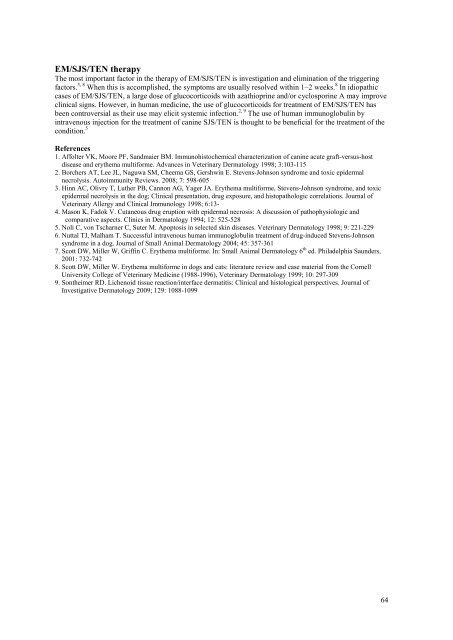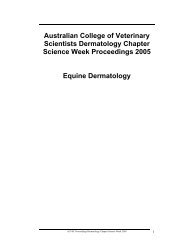Erythema multiforme and toxic epidermal necrolysis
Erythema multiforme and toxic epidermal necrolysis
Erythema multiforme and toxic epidermal necrolysis
You also want an ePaper? Increase the reach of your titles
YUMPU automatically turns print PDFs into web optimized ePapers that Google loves.
EM/SJS/TEN therapy<br />
The most important factor in the therapy of EM/SJS/TEN is investigation <strong>and</strong> elimination of the triggering<br />
factors. 5, 8 When this is accomplished, the symptoms are usually resolved within 1–2 weeks. 8 In idiopathic<br />
cases of EM/SJS/TEN, a large dose of glucocorticoids with azathioprine <strong>and</strong>/or cyclosporine A may improve<br />
clinical signs. However, in human medicine, the use of glucocorticoids for treatment of EM/SJS/TEN has<br />
been controversial as their use may elicit systemic infection. 2, 9 The use of human immunoglobulin by<br />
intravenous injection for the treatment of canine SJS/TEN is thought to be beneficial for the treatment of the<br />
condition. 5<br />
References<br />
1. Affolter VK, Moore PF, S<strong>and</strong>maier BM. Immunohistochemical characterization of canine acute graft-versus-host<br />
disease <strong>and</strong> erythema <strong>multiforme</strong>. Advances in Veterinary Dermatology 1998; 3:103-115<br />
2. Borchers AT, Lee JL, Naguwa SM, Cheema GS, Gershwin E. Stevens-Johnson syndrome <strong>and</strong> <strong>toxic</strong> <strong>epidermal</strong><br />
<strong>necrolysis</strong>. Autoimmunity Reviews. 2008; 7: 598-605<br />
3. Hinn AC, Olivry T, Luther PB, Cannon AG, Yager JA. <strong>Erythema</strong> <strong>multiforme</strong>, Stevens-Johnson syndrome, <strong>and</strong> <strong>toxic</strong><br />
<strong>epidermal</strong> <strong>necrolysis</strong> in the dog; Clinical presentation, drug exposure, <strong>and</strong> histopathologic correlations. Journal of<br />
Veterinary Allergy <strong>and</strong> Clinical Immunology 1998; 6:13-<br />
4. Mason K, Fadok V. Cutaneous drug eruption with <strong>epidermal</strong> necrosis: A discussion of pathophysiologic <strong>and</strong><br />
comparative aspects. Clinics in Dermatology 1994; 12: 525-528<br />
5. Noli C, von Tscharner C, Suter M. Apoptosis in selected skin diseases. Veterinary Dermatology 1998; 9: 221-229<br />
6. Nuttal TJ, Malham T. Successful intravenous human immunoglobulin treatment of drug-induced Stevens-Johnson<br />
syndrome in a dog. Journal of Small Animal Dermatology 2004; 45: 357-361<br />
7. Scott DW, Miller W, Griffin C. <strong>Erythema</strong> <strong>multiforme</strong>. In: Small Animal Dermatology 6 th ed. Philadelphia Saunders,<br />
2001: 732-742<br />
8. Scott DW, Miller W. <strong>Erythema</strong> <strong>multiforme</strong> in dogs <strong>and</strong> cats: literature review <strong>and</strong> case material from the Cornell<br />
University College of Veterinary Medicine (1988-1996), Veterinary Dermatology 1999; 10: 297-309<br />
9. Sontheimer RD. Lichenoid tissue reaction/interface dermatitis: Clinical <strong>and</strong> histological perspectives. Journal of<br />
Investigative Dermatology 2009; 129: 1088-1099<br />
64
















